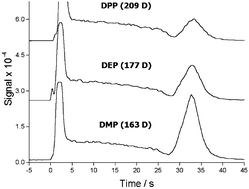Determination of phthalates in water using fiber introduction mass spectrometry
Abstract
Fiber introduction

* Corresponding authors
a
Institute of Chemistry, State University of Campinas (Unicamp), CP 6154, 13083-974 Campinas, São Paulo, Brazil
E-mail:
augusto@iqm.unicamp.br
Fax: +55 19 3788 3023
Tel: +55 19 3788 3057
Fiber introduction

 Please wait while we load your content...
Something went wrong. Try again?
Please wait while we load your content...
Something went wrong. Try again?
R. C. Silva, E. C. Meurer, M. N. Eberlin and F. Augusto, Analyst, 2005, 130, 188 DOI: 10.1039/B411708E
To request permission to reproduce material from this article, please go to the Copyright Clearance Center request page.
If you are an author contributing to an RSC publication, you do not need to request permission provided correct acknowledgement is given.
If you are the author of this article, you do not need to request permission to reproduce figures and diagrams provided correct acknowledgement is given. If you want to reproduce the whole article in a third-party publication (excluding your thesis/dissertation for which permission is not required) please go to the Copyright Clearance Center request page.
Read more about how to correctly acknowledge RSC content.
 Fetching data from CrossRef.
Fetching data from CrossRef.
This may take some time to load.
Loading related content
